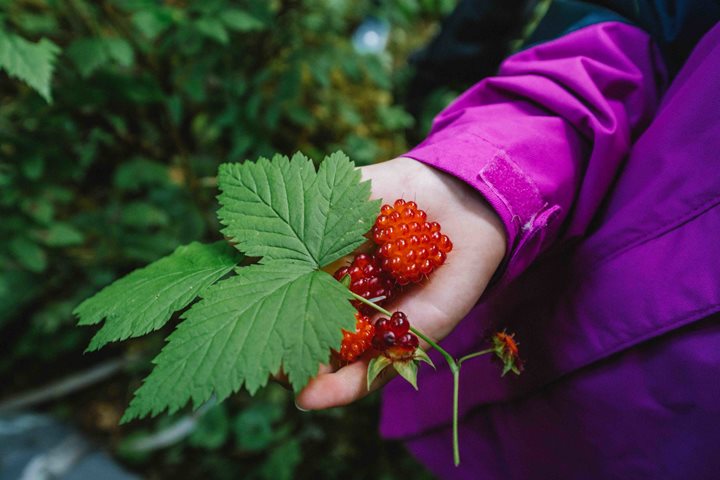Our naturalist Steve Morello says that rainy weather brings the wildlife out, and Thursday did not disappoint. Before our breakfast of smoked salmon and toad in a hole, the young naturalist aboard spotted a humpback whale, porpoises, and bald eagles off the port deck. We dropped anchor amongst the Inian Islands, within one of the world’s largest protected wilderness areas. Our morning zodiac tour brought us directly face to face with a lively population of Stellar sea lions, who frequent the area for its rich population of salmon returning to the islands to spawn. Sea birds such as mew gulls and cormorants are gathered around the sea lions to feast on the off catch. The sea lions are very curious and popped their heads up while gathering around our boat to see what we were up to. Two males on the rocks were vociferously engaged in a dispute. A short distance away, a population of sea otters was well camouflaged amidst the kelp while feasting on a sea urchin brunch. The rain also brought good fortune. As our group was leaving the area, one of our shipmates spotted the blow of a small humpback whale, just fifty feet off starboard. The whale was gracious enough to present us with a fluke before diving down below. Before returning to the ship, we paid a visit to the Inian Island Institute, a sustainable ecology and experiential education center in Hobbit Hole. Afternoon hikes at Fox Creek on Chichagof Island allowed us to explore the area on foot. Some of our group went on a photo walk and others took a kayak tour of the bay. We discovered perennial bear tracks near a salmon stream as well as a scratching tree and a salmon abandoned in the woods. These tracks, sometimes named “Hot Feet” locally, represent a trail where bears return to step in each other’s footprints. Naturalists think that the hot feet may serve as a pheromone based communication system similar to those that dogs use on their habitual walking paths. After our return, our two Grosvenor Teacher Fellows, Kacy Lebby and Elisabeth Gambino, worked with our young naturalists to microscopically examine the plankton samples collected at Kelp Bay last night. The young naturalists used ship based texts to catalogue and illustrate the zooplankton identified from the plankton tow and presented them to the ship during the daily recap. The evening came to an enjoyable close when local author Kim Heacox came aboard to regale us with songs stories, and to talk to us about his books.
8/1/2019
Watch
National Geographic Venture
Baranof Island
After exploring the glaciers and open waters of the northern Inside Passage, we sailed south through the night and returned to the starting point of our journey, Baranof Island. This island, along with Admiralty to the east and Chichagof to the north, is home to one of the highest densities of brown bears in the world. To search for evidence of the bears as they begin their yearly salmon feast and continue our exploration of the temperate rainforest, we anchored in Kelp Bay to kayak and hike the shoreline throughout the morning. Later in the afternoon, we welcomed Dr. Andy Szabo of the Alaska Whale Foundation to learn more about ongoing research taking place in Alaska on the unique bubblenet feeding behavior we witnessed earlier in the trip. Only in Alaska can you experience the forest, salmon, bears, and whales all in one day.






